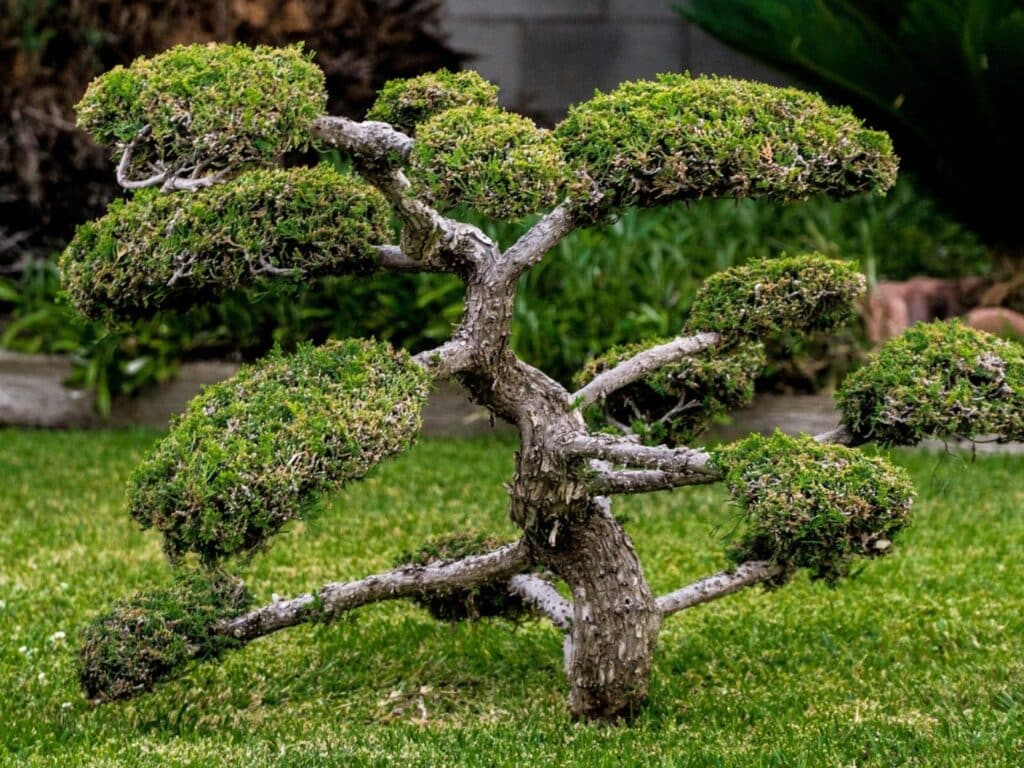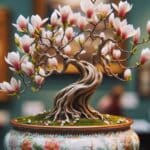Outdoor bonsai trees can add a lot of charm to your outdoor spaces. They are very useful as an ornamental arrangement on outdoor garden tables and can be used to create a striking focal point in a sunny part of your garden.
Outdoor bonsai trees are often easier to grow and care for than indoor bonsai trees because it is easier to supply the tree with adequate sunlight, and outdoor environments are naturally more humid.
There are a lot of great tree species that can be used to create stunning bonsais. Some of the best varieties include junipers, elms, cedars, maples, azaleas, cypress, olives, pomegranates, boxwoods, and oak trees.
Let’s take a closer look at these tree species that are suitable for outdoor bonsai and discuss how to take good care of them.
10 Best Outdoor Bonsai Cultivars
Some outdoor mini trees are easier to grow and care for than others. If you are a complete beginner, it is best to focus on varieties like junipers, elms, boxwoods, or pomegranate trees that are easy to grow and maintain.
If you are an experienced bonsai artist or have more time for care and maintenance, try more intermediate species like olive trees or cypress trees.
Here are the 10 best outdoor bonsai cultivars to grow in your yard.
#1 Juniper Bonsai

The Juniper tree (Juniperus) is one of the most popular tree species for bonsai creations because it produces lots of deadwood that can look charming, especially if you incorporate other natural features like rocks and moss in your bonsai display. The delicate needle-like foliage also gives the tree a miniaturized appearance.
This outdoor bonsai loves plenty of direct sunlight but needs a little winter protection if the temperatures drop below 15 degrees F.
These evergreen trees are popular among beginners because they are easy to maintain and shape.
#2 Elm Bonsai

Elm trees (Ulmus) are also popular among bonsai growers, and they can be a good variety to select if you are a bonsai beginner. It is popular among bonsai artists because the tree has a high pruning tolerance and is relatively easy to shape.
This versatile tree grows well outside but can also be kept as an indoor bonsai. Chinese elms love lots of summer sun and can tolerate a lot of heat. Quite a few different varieties of elm are suitable for bonsaiing. Some are deciduous, some are semi-deciduous, and most are loved for their vivid foliage colors.
#3 Cedar Bonsai
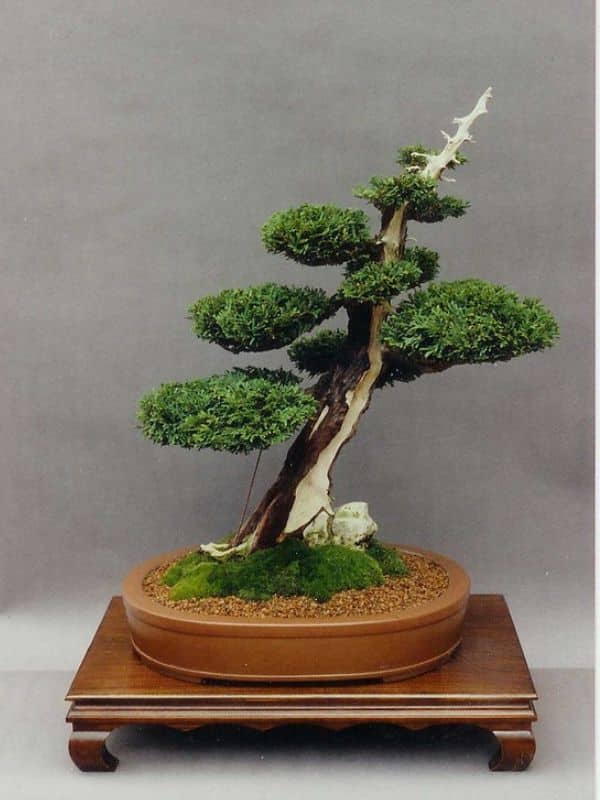
Cedar trees (Cedrus) can also be very functional for growing an outdoor bonsai tree, but they need protection from the cold in extremely cool regions. This tree species is famous for bonsai because it has a textured trunk, and the needle-like foliage can give the tree a more scaled appearance.
These trees are only suitable for outdoor conditions and are often used for larger or imperial bonsai creations. The tree is relatively easy to grow but it grows slowly. It can take many years to transform a young sapling into a bonsai with a mature appearance.
#4 Maple Bonsai

A maple tree (Acer) bonsai can add lots of color to your garden when its deciduous leaves transform into golden, orange, or red hues in autumn. Its bright foliage colors make it one of the most prized bonsai species in the world.
Over 120 different species of maple tree can be used for growing bonsai. These beautiful trees are often recommended for bonsai beginners because they are relatively easy to maintain and don’t need that much care to keep them alive and happy.
#5 Azalea Bonsai
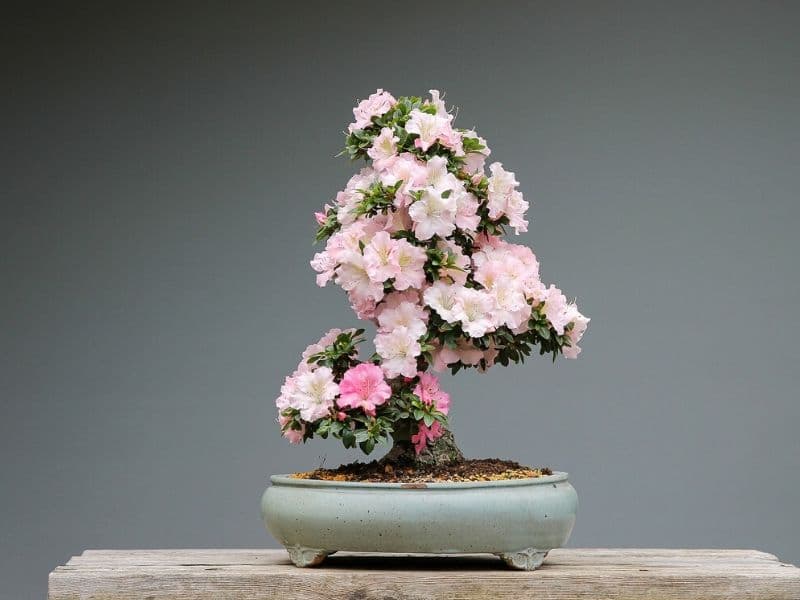
The azalea tree (Rhododendron) is one of the most common tree varieties used for creating showy flowering bonsais. The Satsuki and Kurume azalea are especially popular because they are evergreen and these small shrubs bloom quite vigorously during spring. There are many varieties of these trees and they come in many different flower colors.
This little hybrid is perfect for bonsai beginners because they are easy to train and care for.
#6 Cypress Bonsai
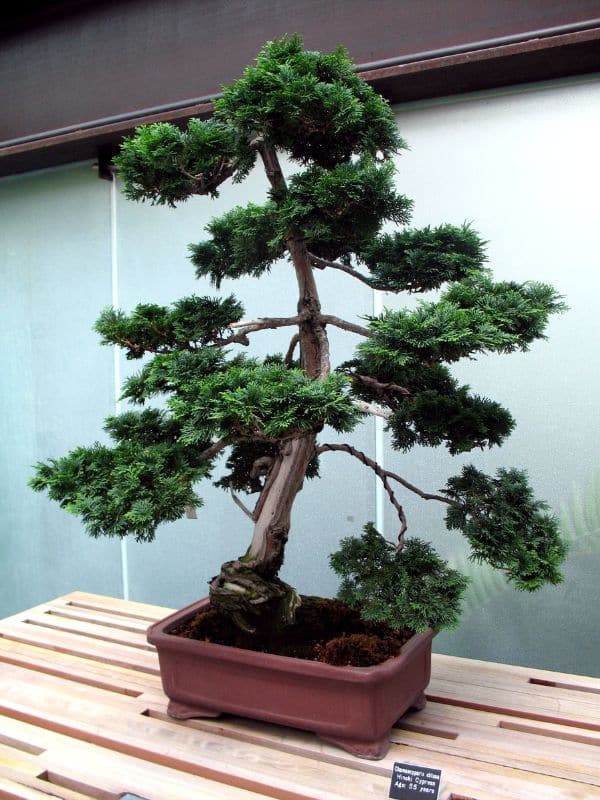
Cypress trees (Cupressus) are a conifer species and can be used as an outdoor bonsai since they grow well in shallow or deep containers. The tree’s delicate foliage is ideal for smaller or mini bonsai creations.
This plant species can be challenging to maintain since a part of the root needs to be untouched during repotting or the tree might suffer. These trees need more maintenance since they must be repotted every two years.
These plants love lots of sunlight but should be protected from icy winds during winter.
#7 Olive Bonsai
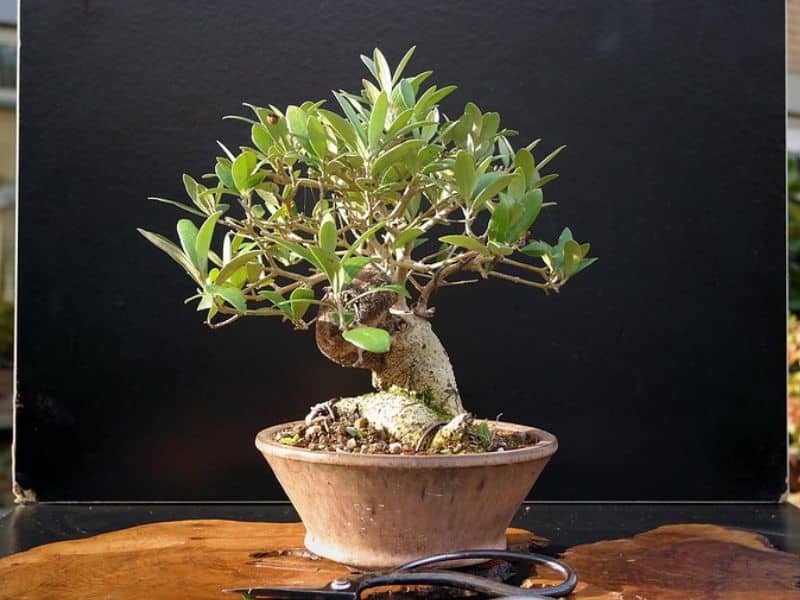
Olive trees (Olea europaea) make charming bonsais, and the wild olive (Olea europaea sylvestris) is the best variety to use to grow a charming miniature tree. Their silvery or grey-green leaves make this bonsai look slightly more unique than your average mini tree specie.
Olive trees are very hardy and easy to care for. They are quite drought tolerant, their evergreen foliage is easy to prune, and the trees can flourish in extreme heat but can be slightly sensitive to frost.
Even though they are easy to care for, they can be quite challenging to grow since these bonsai require trunk chopping, wiring, and repotting to keep them small and achieve a desirable shape. These growing strategies can weaken your tree, and they can die if you are not careful enough.
#8 Pomegranate Bonsai
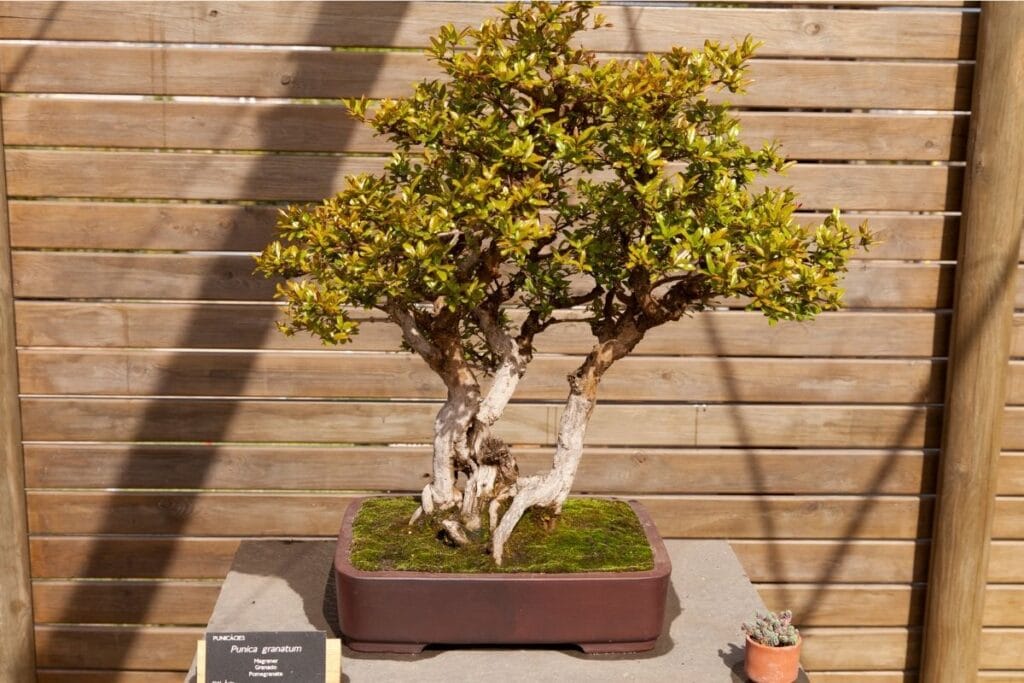
Pomegranate trees (Punica granatum) are another excellent option for a tree that produces vivid flowers and cute, bright red fruits.
This type of bonsai isn’t too difficult to grow and maintain, and they are ideal for outdoor environments but can also grow indoors with enough sunlight.
The trees love plenty of bright sunlight and can tolerate a lot of intense heat as well as dry spells. Pomegranate bonsai prefer a little shade during wintertime and watering should be reduced when it is cold.
#9 Boxwood Bonsai

Boxwood shrubs (Buxus) are ideal for a bonsai beginner because they are robust and can grow in various conditions. These shrubs can grow well in any soil type as long as it is kept moist. They grow well in full sun or shade and can be kept indoors or outdoors. They also tolerate regular pruning very well.
Even though this plant is a shrub, it can easily be pruned and shaped to form a beautiful mini tree. The shrubs also have a relatively quick growth rate, which means you can have a pretty decent-looking tree within just a few years.
#10 Oak Bonsai
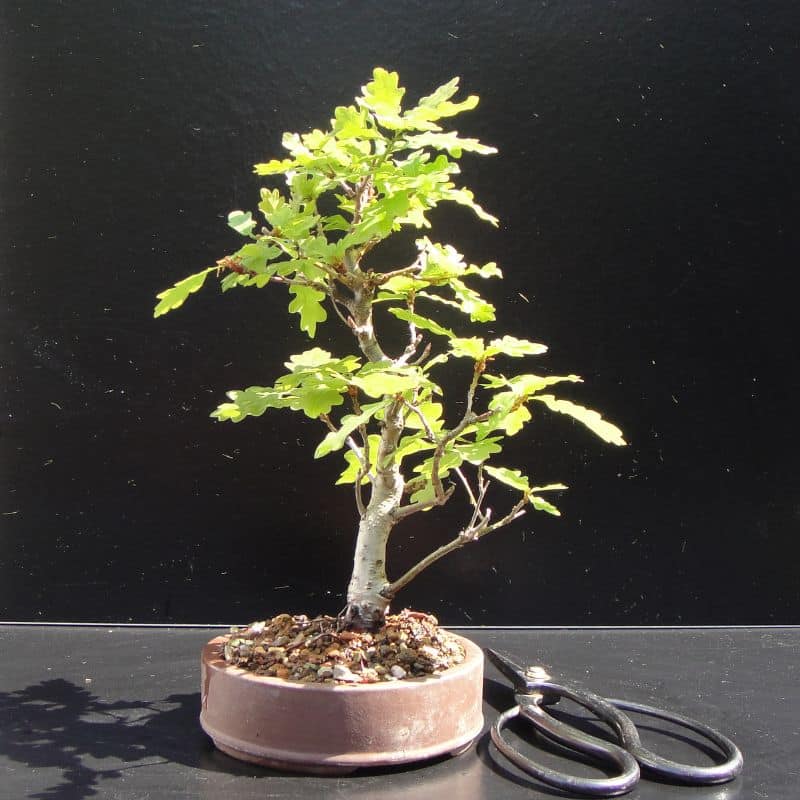
Oak trees (Quercus) are also frequently used for bonsai. These trees are easy to grow and care for and can tolerate frost quite well. These trees are known for their strong trunks, producing sprawling branches that can give the bonsai a very interesting appearance.
Growing this type of bonsai tree from sapling is usually best because it can be difficult to shape the stem once it becomes woody.
How To Grow an Outdoor Bonsai Tree
Generalizing the growing methods for outdoor bonsai trees is very difficult because their growing and caring needs can vary for different species.
Some can tolerate warmer and dryer conditions while other outdoor trees might prefer a cooler, partially shaded, and moist environment.
The first thing you should do if you want to grow and care for an outdoor bonsai is study its species. Here is a quick look at how most outdoor bonsai trees grow.
Propagation
Outdoor bonsai trees are mostly grown from seed or cuttings. If you are developing a mini bonsai tree, starting your bonsai from seed is usually best since saplings are easier to keep small or manipulate into bonsai shapes.
If you are growing a larger bonsai tree, you can also grow it from cuttings. The cutting should still be young enough to allow you to train, cut and manipulate it easily.
Growing Outdoor Bonsai from Seed
Most tree seeds must be soaked in water for a day or two before planting in the soil. After planting them in potting soil, they can be placed in a warm area with indirect light. It is usually best to cover the container with plastic until the seeds germinate. The plastic cover should be removed daily to allow the seeds to breathe.
Growing Outdoor Bonsai from Cuttings
If you are propagating from cuttings, then it is best to start with young cuttings. Dip the cuttings into growing hormones and place them in potting soil. The cuttings should also be covered with a plastic bag to build humidity. The plastic bag should be removed daily to allow the cuttings to breathe. Once the cuttings start growing, the bag can be removed.
Soil
It is best to plant your outdoor bonsai in a bonsai oil mixture. Normal garden soil and normal potting soil are usually too dense for bonsai trees.
A good bonsai soil mixture usually includes ingredients like pumice, lava rock, and akadama or it can contain a mixture of calcined clay, pine bark, and lava rock. This type of mixture is nutrient-rich and won’t harden as much over time.
Pruning
Most outdoor bonsai tree species are pruned during the growing season from early spring to late fall. Some bonsai growers like to prune deciduous bonsai trees in early spring because it is easy to see the branches and to wire the tree when all of the leaves have fallen off.
Bonsai pruning usually begins by removing all damaged leaves or dead wood. Afterward, you can start trimming out crossed and unwanted branches that tend to rub against each other or that might get in the way of preferable growth.
Most twigs on the tree will need to be cut back sot hey will only have 3 – 4 nodes. This will support more branching so your tree will achieve a fuller appearance. It is also helpful for keeping the tree nice and small.
Outdoor bonsai trees might need several pruning sessions throughout the growing season. As the plant grows, you will need to keep removing overly large leaves and any branches that become too tall.
Styling
Styling a bonsai can be a bit tricky, and it might take some practice before you become good at this bonsai practice. It is usually best to style your little tree before the growing season starts because new branches and leaves are easily damaged.
Research bonsai shapes and choose a style that suits your tree species and its natural branch structure.
Cut back unwanted or large branches or branches with unnatural twists or an unsuitable growth pattern.
Select the branches you want to keep and study them to discover the best way to modify them.
Use copper or aluminum wire to wrap the branches and twist them into a desirable bonsai shape. You can also use guy wires to bend some thicker branches downwards to give the tree a more aged appearance.
Leave these wires on for about six weeks. The wires should be removed before they start cutting into the bark.
Repotting and Transplanting
Depending on the tree species, outdoor bonsais are usually repotted once every 2 – 5 years. Repotting is important because the tree requires new potting soil to stay nourished. When the tree is repotted, the root system should also be trimmed back to prevent overgrowth and to keep the tree small.
Please remove it from the container to repot your little tree and carefully loosen the soil around the roots. One-third of the root system should be trimmed away.
The plant can then be planted in fresh bonsai soil. The roots can be wired down to the container through the pot’s drainage holes if the tree is a bit top-heavy.
Keep the little tree moist until the roots recover but don’t over-water your tree since this may result in root rot.
How to Care for an Outdoor Bonsai Tree
Outdoor bonsai trees are usually pretty easy to care for. They tend to be easier to maintain since indoor bonsais often require growth liths and humidity trays to recreate a more desirable environment.
Here is a quick look at how to take good care of your outdoor bonsai tree.
Water
The watering schedule for outdoor bonsai trees might vary for different tree species. Boxwoods, for example, need to be kept moist. Olive trees or pomegranate trees, on the other hand, are quite drought tolerant.
It is important to research your little tree properly and to find out what its watering needs might be. You should also keep in mind that containers tend to dry out faster than natural soil. Your little tree will likely need more frequent watering compared to a tree in the ground.
Sunlight
Outdoor bonsai tree species tend to prefer lots of direct sunlight. You should place your little tree where it will receive a minimum of 6 hours of direct sunlight per day. This is especially important for flowering trees or fruit trees because they won’t bloom if they don’t get enough direct sunlight.
Some tree species like boxwoods prefer partial shade positions over full sun positions. In particularly hot regions, it is also better to establish your tree in a partial shade position with some afternoon shade.
Temperature and Humidity
Outdoor environments have higher humidity levels compared to indoor or walled environments. Your outdoor tree should grow pretty well without a humidity tray but you can position it close to a water feature if you are worried that it might be too dry.
Most outdoor bonsai trees love tropical and warm climates and should grow well in warmer gardens. Some species are, however, a little bit sensitive to the cold and should be protected if the temperatures drop below 15 degrees F.
Fertilizer
Bonsai trees need to be fertilized about once a month because these trees do have limited access to soil nutrients. It is best to use a liquid fertilizer or plant food on your plant and you should be careful not to introduce a high concentration of fertilizer since this can cause damage to its roots. Fertilizing can be reduced during the winter months.
Pests and Diseases
Bonsai trees can suffer from the same pests and diseases as any other plant or any full-sized tree can suffer from. These trees do tend to be vulnerable to problems like rust and they can develop fungal growth on their roots if they are watered too often. With most bonsai trees, you should also keep an eye out for caterpillars, snails, and slugs.
Conclusion
Some of the best outdoor bonsai species include tree varieties like junipers, elms, cedar, maple, azalea, cypress, olive, pomegranate, boxwood, and oak trees. These low-maintenance species are relatively easy to grow and maintain and prefer sunny outdoor environments. They also respond well to frequent pruning and repotting.
Many different bonsai species can be successfully kept in the garden. We hope our guide made it easier to identify a suitable plant for your garden and that you will have a lot of fun growing your small tree into a beautiful bonsai.
Up next: 5 Giant Bonsai Trees and a List of Big Bonsai Tree Species to Select for Larger Bonsai Creations

